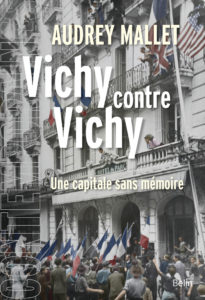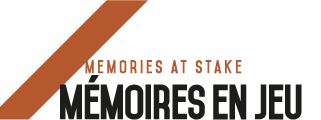
The Center for the History of the Resistance and Deportation (CHRD) in Lyon—housed in a con- verted military hospital that was used by the Gestapo during World War II—is a must “place of memory” for any resident or visitor. Besides the documentary film on the 1987 Klaus Barbie trial that took place in Lyon and richly documented temporary and permanent exhibits, the Center hosts a lecture series each year, usually centered around a recent scholarly publication. On June 13, 2019, the history professor and Vichy native Audrey Mallet presented her new book Vichy contre Vichy: Une capitale sans mémoire (Belin, 2019) along with the French/English smartphone applica- tion “Vichy, 1939-1945” which she developed with a team of collaborators interested in reaching out to non-specialists and filling the silence surrounding Vichy’s role in World War II with more and better communication accessible to all. Whether such supplementary “apps” save or sink scholarship and scholarly publishing is a question that would merit a lecture series of its own.
The narrative Professor Mallet tells follows a rise-fall-restoration trajectory. France has no crude oil or gas reserves, but it does have hot springs and bubbly water in abundance, and Vichy made its reputation under the Second Empire as “La reine des villes d’eau”; i.e., France’s premiere thermal spa town. Napoleon III and afterwards the leaders of the Third Republic invested in the train and telephone infrastructure necessary to allow heads of state and other European elites to gather at this idyllic location in central France while remaining in touch with important matters back home. Possessing the third highest number of rooms to let after Paris and Nice, having a relatively homogenous local population used to serving higher-ups, and being a safe distance from fractious crowds in Paris and Lyon, all made Vichy the obvious choice as the capital of France in the unoccupied zone after the Armistice was signed with Germany on June 22, 1940. With some exceptions such as the resistance network Alliance, Vichy residents adopted a mostly go-along-to-getalong attitude, Mallet explains, for principally four reasons: the economy depended on selling water and on tourism; the military presence; government ownership of the leased water resources; and ties that developed between locals and newcomers, especially the widespread fondness for the avuncular new head of state, Marshall Pétain. According to Mallet, Vichy was no more anti-Semitic than other French towns, but it did expel 3,000 Jews in 1940, even before the passage of such laws made it official policy, and later organized the expulsion of many more. After the war Vichy was eager to subscribe to the Gaullist myth of resistance and Vichy as “shield”; and whenever that failed to convince, it would adopt the inverse self-representation as victim and martyr. In the aftermath of Algerian independence in 1962, Mallet explains, Vichy’s renewed popularity as a spa town received an added boost thanks to unapologetic nostalgia for Pétain’s fascistic National Revolution project which dovetailed nicely with nostalgia for French colonialism and resentment over a perceived grandeur deficit after the loss of the empire. Thus, for the next forty years—as though the writings of Robert Paxton and the debates they generated didn’t exist—Vichy would rely on pragmatic silence and selective messaging, depending on who was listening, to keep the water and tourist economy flowing. Borrowing the terminology of Timothy Snyder in his The Road to Unfree- dom (2018), one can see from Mallet’s presentation how for progressives Vichy, both the city and the régime, could be cast within a politics of inevitability—“Of course the French Republic would reemerge after the foreign enemy was defeated!”; while those disappointed by more “strange defeats” in Indochina and Algeria and France’s reduced imperial influence around the globe could find in Vichy a reassuring “politics of eternity” thanks to the Second Empire and Belle Époque architecture that would, like a movie set, give the impression that France’s colonial empire lived on as great and glorious as ever. Indeed, both a diehard Republican and a fervent farright nationalist can stroll through the city today with a guidebook, living person, or now a user-friendly smartphone app and indulge their fondness for what Snyder calls the fable of the wise nation—“the mistaken belief that their country has a history as a nation-state”—all the while grumbling together about the alleged oppression exerted by faroff European Union technocrats.
Mallet concluded her presentation with what a history professor could only welcome as good news; namely a change in local leadership in 2017 following a change of attitude that now supposedly favors truth-telling over the loose circulation of rumors and misinformation. Hence the recent implementation of policies more favorable to the circulation of reliable information and informed debate about what happened in and around Vichy during World War II. Besides co-financing the smartphone app, the city of Vichy now employs four or five paid docents who lead tours of the city that review Vichy’s colonial and World War II history. However, they are no doubt as adept as their forebears and present-day coworkers in the hospitality trades when it comes to reading their audience and giving a more somber or picturesque narrative as circumstances advise. Mallet’s book and the mobile app are the clearest sign of a new chapter in the historiography on Vichy which may prove to be more mindful and open about the town’s colonial and World War II past, so long as its users are willing to go beyond their received ideas and comfort zones—something Mallet’s tools clearly permit but cannot alone enforce, since remembering and thinking historically, with all that those actions entail, are ultimately up to each individual.
L’application « Vichy 1939-1945 »
Disponible en français et en anglais, cette application permet aux utilisateurs d’effectuer une visite guidée du Vichy des années 1939-1945 en complète autonomie. Les points d’intérêt sélectionnés traitent à la fois de l’histoire nationale et de l’histoire locale.
Pour chacun d’eux, l’utilisateur a accès à un texte historique bref mais précis (Que s’est-il passé ici pendant la guerre ? Pourquoi ? Comment ? ) ainsi qu’à plusieurs sources primaires exclusives.
Tous les documents d’archive sont proposés en libre accès et peuvent être agrandis afin de faciliter leur lecture. Les différents points d’intérêt peuvent être identifiés via une carte GPS ou via une liste de thèmes.
